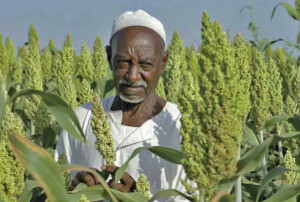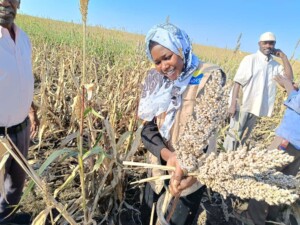Deadly floods across Sudan
The volume of water the Blue Nile at the Sudan-Ethiopian border reached 728 million cubic metres as Khartoum recorded a water level of 16.92 metres, exceeding the flood level by 42 centimetres according to an update on Sunday by the Flood Committee of the Sudanese Ministry of Irrigation and Water Resources. Torrential rains and flash floods across Sudan have caused loss of life and property in at least eight states, affecting over 12,200 people according to initial assessments.
 Scenes of flood gdevastation in River Nile state this week (Picture: Hadreen)
Scenes of flood gdevastation in River Nile state this week (Picture: Hadreen)
The volume of water the Blue Nile at the Sudan-Ethiopian border reached 728 million cubic metres as Khartoum recorded a water level of 16.92 metres, exceeding the flood level by 42 centimetres according to an update on Sunday by the Flood Committee of the Sudanese Ministry of Irrigation and Water Resources. Torrential rains and flash floods across Sudan have caused loss of life and property in at least eight states, affecting over 12,200 people according to initial assessments.
In the Nile valley, the floods forecasts that the level of the Roseires-Sennar sector of the river will be stable, however the Sennar-Khartoum sector can expect an increase of three centimetres and the Khartoum-Shendi sector would show an increase of five centimetres.
It also predicted that the Shendi-Atbara sector of the Nile can expect a rise of seven centimetres, while the Atbara-Merowe sector is expected to be stable. The committee reiterated its call for the public in all sectors of the river to exercise caution.
River Nile sate (Video: Hadreen)
In Khartoum, torrential rain on Sunday morning flooded most of the main roads and neighbourhoods in the capital, and video footage from the capital showed the airport road, Jabra, Afra tunnel, and others flooded with water which obstructed the movement of vehicles, and prevented employees and workers from reaching their places of work.
At least ten 10 people have died and four others were injured after heavy rains in River Nile the state last week. The Humanitarian Aid Commission of River Nile state said in a report on Saturday that the deaths were due to electrocution and the collapse of buildings, explaining that the survey included six localities, where 2,682 people were affected.
In North Kordofan, traffic police prevented the passage of private vehicles on the National Export Road because of flooding. The main water station in Sudri was also flooded early on Sunday, cutting off the supply of drinking water from all sub-distribution stations in the town’s neighbourhoods.
In North Darfur, the newly constructed “Canadian” dam collapsed in the area of the local administrative unit. The dam was built as part of water harvesting projects, through Al Bayan Construction Company and with the support of the Italian organisation Kobe.
OCHA: 'Heavy rains and flash flooding have so far affected eight out of 18 states across the country affecting over 12,200 people'
OCHA
In an update published today, the UN Office for the Coordination of Humanitarian Affairs (OCHA) in Sudan points out that heavy rains and flash flooding have so far affected eight out of 18 states across the country affecting over 12,200 people. Homes, infrastructure, and farmland have been either damaged or destroyed. Over 800 homes have reportedly been destroyed and over 4,400 homes damaged. States affected include El Gezira, El Gedaref, North Kordofan, River Nile state, South Darfur, South Kordofan, West Darfur, and White Nile state. Assessments are ongoing to confirm the number of people affected and identify their needs, OCHA says.

West Darfur
On 6 August, 70 shelters in Nadi Tadamon internally displaced persons (IDP) gathering site in El Geneina locality was affected by flash flooding due to heavy rains. The gathering site is in a low-lying area that is at risk of flooding. Reportedly, a six-year-old child died, and three women were injured. The Government’s Humanitarian Aid Commission (HAC) and the local community identified a safer area on higher land where the IDPs of Nadi Tadamon gathering can be relocated.
On 7 August, heavy rains were reported in Ardamata, Al Rayad, and Dorti IDP camps in El Geneina locality. In Ardamata IDP camp, heavy rainfall caused damage to IDP shelters, and some shelters are at risk of collapsing. IDPs are also at high risk of contracting vector-borne diseases such as malaria due to the stagnant rainwater in the camps. In Al Rayad IDP camp, 85 IDPs (17 homes) were affected by heavy rains and flooding. The IDP camp is at high risk of flooding as rainfall is expected to continue in August. The water pond located to the northeast of the camp is full and coupled with the poor drainage system the IDP camp could flood.
Heavy rains have also led to stagnant water in Nasim area in El Geneina locality with reports of minor damage to some homes. Inundation is affecting movement in the area. An estimated 627,000 people live in El Geneina locality, according to the 2021 Sudan Humanitarian Needs Overview (HNO), of whom over 258,000 people are in crisis and above levels of food security between June and September 2021, according to the latest Integrated Food Security Phase Classification (IPC) report.

Northern State
On 4 and 5 August, 2,290 people (458 families) were affected by heavy rains in five localities in Northern State. According to the assessment lead by the Sudanese Red Crescent Society (SRCS), 42 people were injured, including six by electric shock. Localities affected include Dongola (189 homes), Delgo (30 homes), Ad Dabbah (67 homes), Merowe (89 homes) and Al Golid (83 homes). The heavy rains and strong winds damaged an unconfirmed number of health facilities, agricultural land and crops, as well as electric lines and poles.











 and then
and then